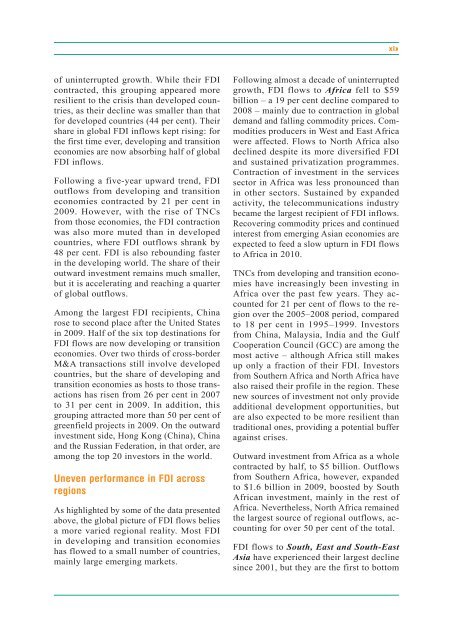UN World Investment Report 2010 - Office of Trade Negotiations
UN World Investment Report 2010 - Office of Trade Negotiations
UN World Investment Report 2010 - Office of Trade Negotiations
Create successful ePaper yourself
Turn your PDF publications into a flip-book with our unique Google optimized e-Paper software.
<strong>of</strong> uninterrupted growth. While their FDI<br />
contracted, this grouping appeared more<br />
resilient to the crisis than developed countries,<br />
as their decline was smaller than that<br />
for developed countries (44 per cent). Their<br />
share in global FDI inflows kept rising: for<br />
the first time ever, developing and transition<br />
economies are now absorbing half <strong>of</strong> global<br />
FDI inflows.<br />
Following a five-year upward trend, FDI<br />
outflows from developing and transition<br />
economies contracted by 21 per cent in<br />
2009. However, with the rise <strong>of</strong> TNCs<br />
from those economies, the FDI contraction<br />
was also more muted than in developed<br />
countries, where FDI outflows shrank by<br />
48 per cent. FDI is also rebounding faster<br />
in the developing world. The share <strong>of</strong> their<br />
outward investment remains much smaller,<br />
but it is accelerating and reaching a quarter<br />
<strong>of</strong> global outflows.<br />
Among the largest FDI recipients, China<br />
rose to second place after the United States<br />
in 2009. Half <strong>of</strong> the six top destinations for<br />
FDI flows are now developing or transition<br />
economies. Over two thirds <strong>of</strong> cross-border<br />
M&A transactions still involve developed<br />
countries, but the share <strong>of</strong> developing and<br />
transition economies as hosts to those transactions<br />
has risen from 26 per cent in 2007<br />
to 31 per cent in 2009. In addition, this<br />
grouping attracted more than 50 per cent <strong>of</strong><br />
greenfield projects in 2009. On the outward<br />
investment side, Hong Kong (China), China<br />
and the Russian Federation, in that order, are<br />
among the top 20 investors in the world.<br />
Uneven performance in FDI across<br />
regions<br />
As highlighted by some <strong>of</strong> the data presented<br />
above, the global picture <strong>of</strong> FDI flows belies<br />
a more varied regional reality. Most FDI<br />
in developing and transition economies<br />
has flowed to a small number <strong>of</strong> countries,<br />
mainly large emerging markets.<br />
xix<br />
Following almost a decade <strong>of</strong> uninterrupted<br />
growth, FDI flows to Africa fell to $59<br />
billion – a 19 per cent decline compared to<br />
2008 – mainly due to contraction in global<br />
demand and falling commodity prices. Commodities<br />
producers in West and East Africa<br />
were affected. Flows to North Africa also<br />
declined despite its more diversified FDI<br />
and sustained privatization programmes.<br />
Contraction <strong>of</strong> investment in the services<br />
sector in Africa was less pronounced than<br />
in other sectors. Sustained by expanded<br />
activity, the telecommunications industry<br />
became the largest recipient <strong>of</strong> FDI inflows.<br />
Recovering commodity prices and continued<br />
interest from emerging Asian economies are<br />
expected to feed a slow upturn in FDI flows<br />
to Africa in <strong>2010</strong>.<br />
TNCs from developing and transition economies<br />
have increasingly been investing in<br />
Africa over the past few years. They accounted<br />
for 21 per cent <strong>of</strong> flows to the region<br />
over the 2005–2008 period, compared<br />
to 18 per cent in 1995–1999. Investors<br />
from China, Malaysia, India and the Gulf<br />
Cooperation Council (GCC) are among the<br />
most active – although Africa still makes<br />
up only a fraction <strong>of</strong> their FDI. Investors<br />
from Southern Africa and North Africa have<br />
also raised their pr<strong>of</strong>ile in the region. These<br />
new sources <strong>of</strong> investment not only provide<br />
additional development opportunities, but<br />
are also expected to be more resilient than<br />
traditional ones, providing a potential buffer<br />
against crises.<br />
Outward investment from Africa as a whole<br />
contracted by half, to $5 billion. Outflows<br />
from Southern Africa, however, expanded<br />
to $1.6 billion in 2009, boosted by South<br />
African investment, mainly in the rest <strong>of</strong><br />
Africa. Nevertheless, North Africa remained<br />
the largest source <strong>of</strong> regional outflows, accounting<br />
for over 50 per cent <strong>of</strong> the total.<br />
FDI flows to South, East and South-East<br />
Asia have experienced their largest decline<br />
since 2001, but they are the first to bottom

















